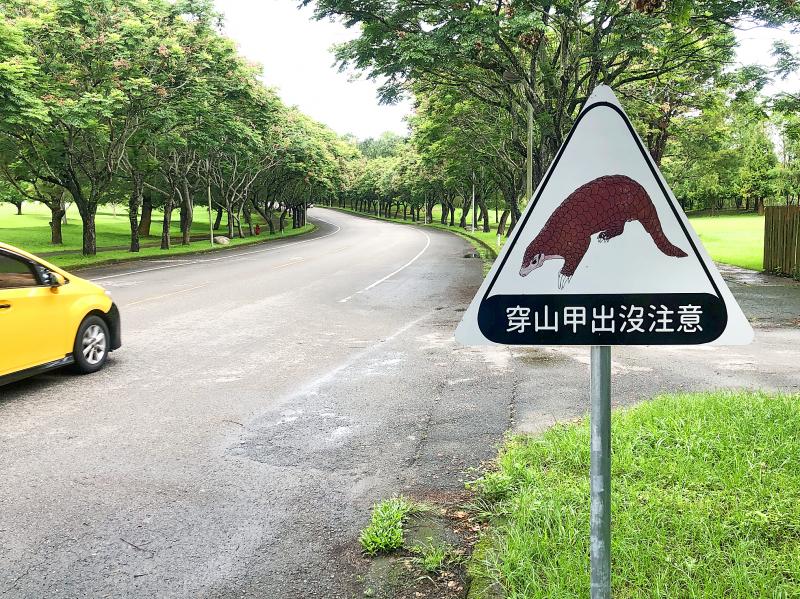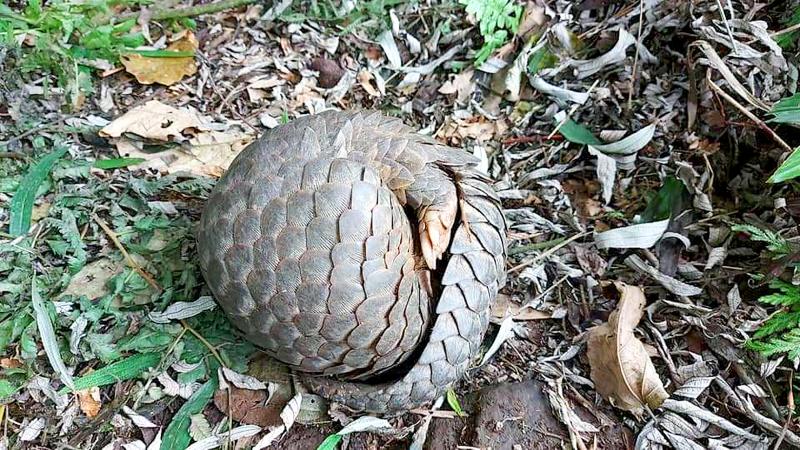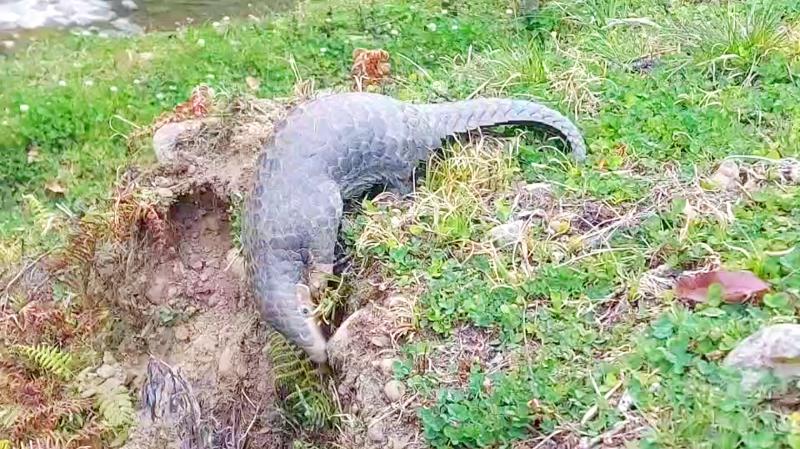Who would have thought that Taiwan — just over 100km from China and a few hundred kilometers away from Vietnam, which are the world’s first and second biggest consumers of pangolin scales — would become the last beacon of hope for this imperiled species? In fact, pangolins — from sub-species in Africa all the way down to Indonesia — are the world’s most highly trafficked mammal.
Thought to cure anything from HIV to hangovers, ground pangolin scales and pangolin soup (the photos online are difficult to stomach) are expensive delicacies in Vietnam and China, and the rarer the species becomes, the more it is sought after — because it is going extinct — creating a dreadful vicious cycle propelling the animal into oblivion.
CONSERVATION

Photo: Tung Chen-kuo, Taipei Times
However, Taiwan’s pangolin populations have recovered from previous hunting campaigns in decades past, and that this scaly anteater-like creature is now somewhat common on the island. Furthermore, pangolin-range countries with dwindling populations of this fascinating mammal (it is its own order in the animal kingdom — Pholidota) were, at least before COVID-19, collaborating with Taiwanese researchers and learning from Taiwan’s success in trying to bring the species back from the brink.
Kurtis Pei (裴家騏), one of the most prominent wildlife conservationists in Taiwan, says that pangolins can now be seen in many rural areas.
“The pangolin is increasing island-wide in the past decades,” Pei says.

Photo courtesy of You Chao-hung
Pangolins can today even be found in places as popular and populated as Yangmingshan (陽明山國家公園), and even on my own university campus — Chang Gung University (長庚大學) — on the Linkou (林口)/Gueishan (龜山) plateau just south of Taipei, I was stunned when one of my students showed me a video he took one evening of a pangolin scurrying at a nervously fast pace near his dormitory once it realized it had been seen.
This recent record, however, did not surprise Pei, who explained that thanks to legislation and stronger law enforcement than can be found in other countries with pangolins, the species began to recover in the 1970s. One of the major factors in drawing down pangolin numbers in Taiwan in the 1960s was demand for its scales to make leather boots in the US.
There was also local consumption of pangolins, and it still exists today, but on a smaller scale. Taiwan’s pangolins were also exported to China in the past, though this has apparently been mostly stopped within recent years.

Photo courtesy of Chen Ke-shuo
GLOBAL COLLABORATION
The Formosan Pangolin (Manis pentadactyla pentadactyla) is a sub-species of the Chinese pangolin (Manis pentadactyla), and one of the three types of pangolin found across Asia. Interestingly, it is the only one of the three whose population is expanding. It is difficult to say exactly how many pangolins exist in Taiwan, but the number is thought to be so impressive that it’s best kept a secret.
So great has Taiwan’s success been in recovering its pangolin population that Malaysia’s Universiti Malaysia Sabah coordinated with National Pingtung University of Science and Technology (NPUST), where Pei is a professor, to learn more about how to save the species.

Photo: Liao Chen-huei, Taipei Times
Research teams from Japan, Germany and Hong Kong have also come here to learn from Taiwan’s accomplishments, and before COVID-19, plans were in the works to collaborate with researchers from Africa as well.
Taiwan has also had notable success in rehabilitating rescued pangolins that had been attacked by feral dogs (one of their main threats in the wild), and Taipei Zoo was the first place in the world where a captive pangolin gave birth to a baby — who goes by the name of Chiung Wu.
A winning combination of talented, dedicated researchers (Taipei Zoo has a “pangolin nanny”), better law enforcement, rescue centers such as Taipei Zoo and NPUST’s Wildlife Animal Shelter, as well as government support in the form of Taiwan’s Wildlife Conservation Act in 1989, all add up to produce the surprising story of Taiwan’s pangolin conservation success.

Photo courtesy of the Taipei Zoo
DO PANGOLINS HAVE A FUTURE?
But there is only so much Taiwan can do for the species globally. They are mercilessly persecuted in every country they are found in. The largest ever seizure of pangolin scales happened in China in 2019 with 23 metric tonnes deriving from approximately 50,000 African pangolins. Similar busts have occurred in Hong Kong.
Pangolins have become so rare in Indochina that they are nearly extinct in Vietnam and Laos, with dogs easily trained to find them. It took us over two years to camera-trap one in our survey in Virachey National Park in Cambodia.
Nonetheless, Taiwan is the global exception in pangolin conservation, and if this mysterious, peculiar, wonderful species is to have a future on Earth, Taiwan will play a major role.

This month the government ordered a one-year block of Xiaohongshu (小紅書) or Rednote, a Chinese social media platform with more than 3 million users in Taiwan. The government pointed to widespread fraud activity on the platform, along with cybersecurity failures. Officials said that they had reached out to the company and asked it to change. However, they received no response. The pro-China parties, the Chinese Nationalist Party (KMT) and Taiwan People’s Party (TPP), immediately swung into action, denouncing the ban as an attack on free speech. This “free speech” claim was then echoed by the People’s Republic of China (PRC),

Exceptions to the rule are sometimes revealing. For a brief few years, there was an emerging ideological split between the Democratic Progressive Party (DPP) and Chinese Nationalist Party (KMT) that appeared to be pushing the DPP in a direction that would be considered more liberal, and the KMT more conservative. In the previous column, “The KMT-DPP’s bureaucrat-led developmental state” (Dec. 11, page 12), we examined how Taiwan’s democratic system developed, and how both the two main parties largely accepted a similar consensus on how Taiwan should be run domestically and did not split along the left-right lines more familiar in

Many people in Taiwan first learned about universal basic income (UBI) — the idea that the government should provide regular, no-strings-attached payments to each citizen — in 2019. While seeking the Democratic nomination for the 2020 US presidential election, Andrew Yang, a politician of Taiwanese descent, said that, if elected, he’d institute a UBI of US$1,000 per month to “get the economic boot off of people’s throats, allowing them to lift their heads up, breathe, and get excited for the future.” His campaign petered out, but the concept of UBI hasn’t gone away. Throughout the industrialized world, there are fears that

Most heroes are remembered for the battles they fought. Taiwan’s Black Bat Squadron is remembered for flying into Chinese airspace 838 times between 1953 and 1967, and for the 148 men whose sacrifice bought the intelligence that kept Taiwan secure. Two-thirds of the squadron died carrying out missions most people wouldn’t learn about for another 40 years. The squadron lost 15 aircraft and 148 crew members over those 14 years, making it the deadliest unit in Taiwan’s military history by casualty rate. They flew at night, often at low altitudes, straight into some of the most heavily defended airspace in Asia.